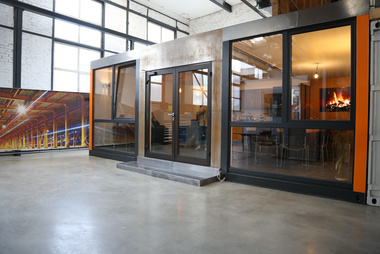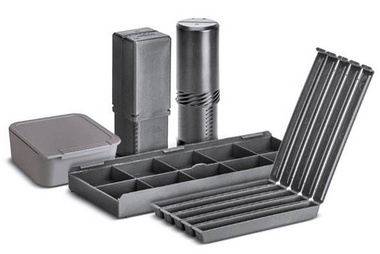Metal band saw blades
Röntgen Bi-Metal Band Saw Blades
Excellent premium quality for high cutting performance with Bi-metal band saw blades in steel construction and steel trade for profile and flat steel processing.
A large and high-quality product selection of metal band saw blades is offered by our partner supplier, the company Robert Röntgen GmbH & Co. KG from Remscheid.
Röntgen bi-alfa cobalt M42
Excellent premium quality for high cutting performance with saw bands from 6 mm up to 10 mm by Röntgen (Remscheid). The version bi-alfa-cobalt metal saw band has a highly flexible carrier band made of high alloy structural steel. This guarantees a very good tensile strength. The teeth tips of HSS-M42 and the high cobalt content guarantee a very good wear resistance and therefore ensure low tool costs. The saw blades are also available with carbide tipping (HM-Titan or HM-Titan forteC), which are especially appropriate for tough materials.
Advantages of Röntgen Bi-Metal saw blades:
- for all steel qualities up to 1400N/mm² and non-ferrous metals
- high cutting performance
- very long durability
- favourable price-performance ratio
- narrow cutting channel/ less scrap
- Precise and straight cut
The Röntgen BI-ALFA band saw blade is particularly suitable for use on mitre band saws from the machine tool manufacturers Behringer, Kaltenbach, Meba, Kasto, Peddinghaus, Ficep and Voortman.
The choice of the optimal band saw blade depends not only on the application (material and profile of the workpiece) but also on the band saw design of the individual manufacturers. The length, width and thickness of a band saw blade depend on the manufacturer's specifications.
Saw band tooth pitch
For the selection of the tooth pitch (ZpZ), the length of mesh of the saw band in the workpiece is relevant. The tooth pitch is determined by the number of teeth (tooth cutting edges) per inch (= 25.4 mm).
A distinction is made between normal gearing and combination gearing.
With normal gearing, the tooth space is always the same. This type of toothing is well suited for sawing uniform material cross-sections.
With the combination gearing, which is mainly used in steel construction and steel trade, the first number corresponds to the largest tooth tip distance and the second number to the smallest tooth tip distance within a teeth group. With the combination gearing, the application range of the saw blade is increased and vibrations that occur when sawing sectional steel and pipes are reduced.
The following tooth pitches are recommended here:
For pipes and steel profiles up to approx. 300 mm material width 3/4 tooth pitch with a step restriction, for material widths above 300 mm 2/3 tooth pitch with step restriction and for profile beams with a high residual tension a tooth pitch of 3/4 in combination with an extra wide step restriction should be selected.
Saw blade tooth shape
The shape of the saw teeth should be chosen to meet the special requirements when sawing tubes, profiles and sectional beams. With interrupted saw cuts, the pressures on a saw blade are higher than when sawing solid material.
Changing the saw band and insert a new saw band:
When changing a saw band, in addition to selecting a suitable new saw band, make sure that the condition of the saw band control and the proper functioning of the chip clearing brush are checked. The filling level for the suitable cooling lubricant and the function of the coolant supply must also be checked.
In order to achieve the longest possible service life of a Bi-metal saw blade and to prevent the finest chipping on the saw teeth, running-in or sawing-in is an important measure. If the running-in process is carried out optimally, the tips of the teeth are ideally rounded and without chipping.
During the running-in process, the machine operator must run the bandsaw for a period of approx. 15 to 20 minutes at a cutting speed (Vc) reduced by approx. 30% and a feed rate (Vf) reduced by approx. 50%. After this run-in process, first the cutting speed and then the feed rate is slowly increased to the previously determined full sawing capacity.
Latest news

New, modern cafeteria inaugurated at Nenok: an oasis for employees and visitorsThe new cafeteria (Kaffeetine) at Nenok was inaugurated today with a joint cooking event. The high-quality interior not…

Vielen Dank für Ihre Treue und Ihr Vertrauen und auf ein erfolgreiches Jahr 2024.Das Nenok-Team möchte sich herzlich für die partnerschaftliche Zusammenarbeit im vergangenen Jahr bedanken und freut…

Liebe Geschäftspartnerinnen und liebe Geschäftspartner aus dem Stahlbau und Stahlhandel,im festlichen Glanz der Weihnachtszeit möchten wir uns herzlich bei Ihnen für Ihre Treue und Zusammenarbeit…

Hartner is setting a milestone in the area of sustainability by gradually introducing packaging made from recycled plastic with immediate effect. This innovative measure makes Hartner the first German…
 Deutsch
Deutsch  English
English  Polska
Polska  Nederlands
Nederlands  Français
Français  Español
Español 




